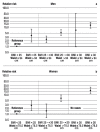Body mass index, waist circumference, and the risk of type 2 diabetes mellitus: implications for routine clinical practice
- PMID: 20644701
- PMCID: PMC2905837
- DOI: 10.3238/arztebl.2010.0470
Body mass index, waist circumference, and the risk of type 2 diabetes mellitus: implications for routine clinical practice
Abstract
Background: Current guidelines for assessing the risk of developing type 2 diabetes mellitus (DM) recommend using the patient's body-mass index (BMI) as a primary measure. Waist circumference measurement is recommended for overweight or obese patients only (BMI > or = 25).
Methods: We studied the interaction between BMI and waist circumference with respect to the risk of developing type 2 DM in a cohort of 9753 men and 15491 women, aged 35 to 65, who participated in the European Prospective Investigation into Cancer and Nutrition (EPIC)-Potsdam. The statistical analysis was performed with multivariable-adjusted Cox proportional hazard regression.
Results: During a mean follow-up interval of 8 years, type 2 DM was newly diagnosed in 583 men and 425 women. A statistically significant interaction was found between BMI and waist circumference with respect to the risk of type 2 DM (p<0.0001). The positive association between waist circumference and diabetes risk was stronger in persons with lower BMI. The relative risk (RR) of developing type 2 DM among persons of low or normal weight (BMI < 25) who had a large waist circumference was at least as high as that among overweight persons (BMI 25-29.9) with a small waist circumference: for the first case, the RR was 3.62 [1.67-7.83] in men and 2.74 [1.52-4.94] in women; for the second case, the RR was 2.26 [1.51-3.37] in men and 1.40 [0.61-3.19] in women (The figures in square brackets are 95% confidence intervals). These relative risks were calculated in comparison to the risk among persons of low or normal weight (BMI < 25) with a small waist circumference.
Conclusion: These findings imply that the waist circumference is an important additional piece of information for assessing the risk of type 2 DM, particularly among persons of low or normal weight.
Figures

Comment in
-
Consider body height.Dtsch Arztebl Int. 2010 Nov;107(46):826; author reply 826. doi: 10.3238/arztebl.2010.0826a. Epub 2010 Nov 19. Dtsch Arztebl Int. 2010. PMID: 21151422 Free PMC article. No abstract available.
References
-
- Hauner H, Buchholz G, Hamann A. Evidenz-basierte Leitlinie Therapie und Prävention der Adipositas. Deutsche Adipositas-Gesellschaft, Deutsche Diabetes-Gesellschaft, Deutsche Gesellschaft für Ernährung (DGE), Deutsche Gesellschaft für Ernährungsmedizin. 2007
-
- World Health Organisation. Obesity: preventing and managing the global epidemic. Report of a WHO consultation. World Health Organ Tech Rep Ser. 2000;894:1–253. - PubMed
-
- Bantle JP, et al. Nutrition recommendations and interventions for diabetes: a position statement of the American Diabetes Association. Diabetes Care. 2008;31(Suppl. 1):61–78. - PubMed
-
- Phillips LK, Prins JB. The link between abdominal obesity and the metabolic syndrome. Curr Hypertens Rep. 2008;10(2):156–164. - PubMed
-
- Haslam DW, James WP. Obesity. Lancet. 2005;366:1197–1209. - PubMed
MeSH terms
LinkOut - more resources
Full Text Sources
Medical

